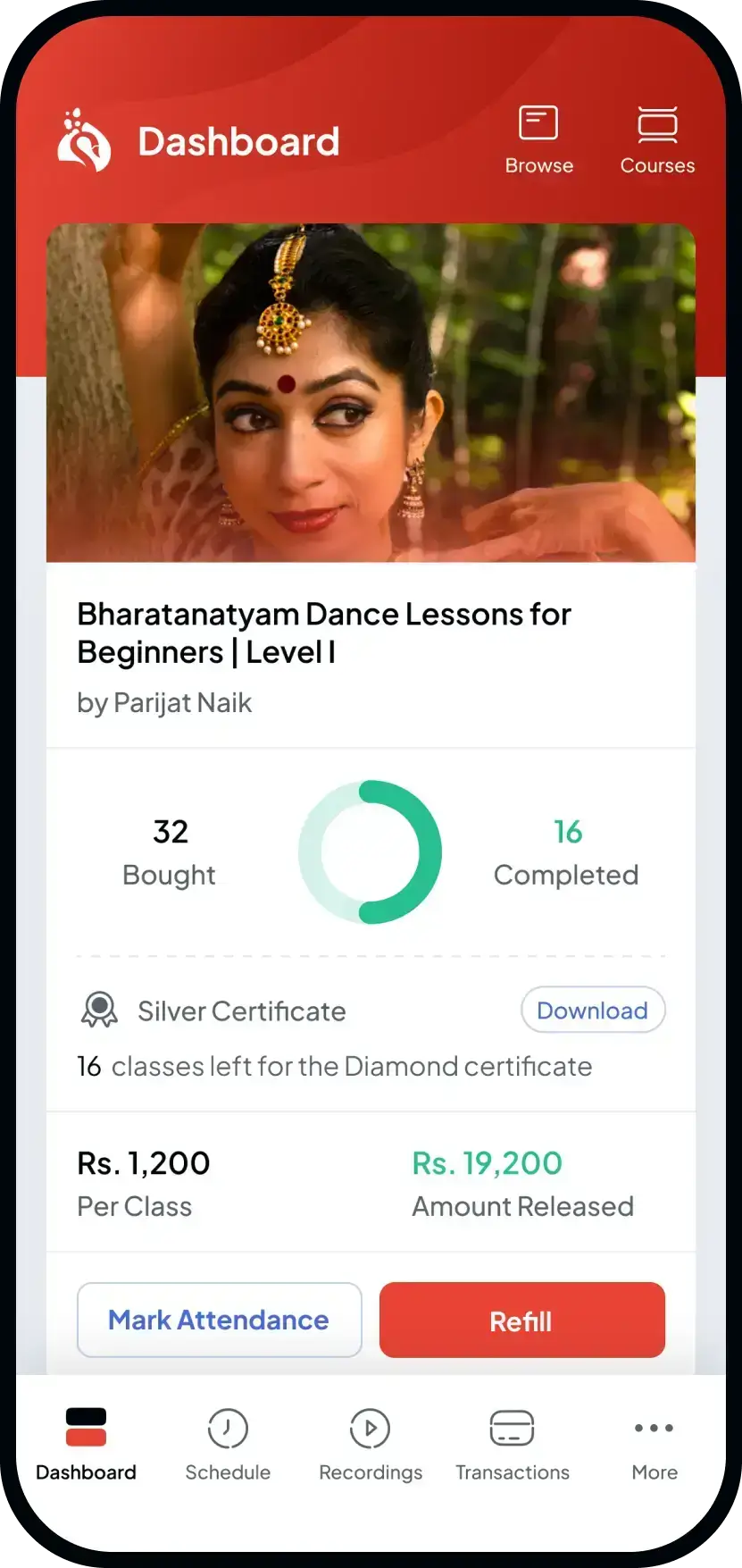Why people love ipassio?
World-class masters as teachers
Personalized & Interactive 1-on-1 classes
Course studio that amplifies learning
Access to the global creative community
Pay as you go - 2 classes at a time
World-class masters as teachers
Personalized & Interactive 1-on-1 classes
Show more
Explore Online Ghatam Courses

Our Happy Learners

Real Progress, Real Impact
Let’s celebrate passion learning
About Online Ghatam lessons
How to play ghatam lessons for beginners?
In order to learn to play ghatam, students must learn how to position the instrument correctly while sitting. The mouth of the pot is placed towards the belly and you play ghatam with your wrist, hand, and nails. An expert teacher can guide the student by adjusting the distance between the mouth and the belly to vary the tone of the instrument. When you switch the part of hand with which you strike the pot, the tone changes. Ghatam is an instrument where it isn’t difficult for a rookie to produce sound, so it can be very beginner-friendly. For the same reason, it is critical to get guidance from an expert teacher to set you on the correct track right from the beginning.
Why ghatam lessons from ipassio?
ipassio hosts top ghatam players in the world including senior disciples of T.H. Vikku Vinayakram and others. Learning directly from such senior artists will improve the foundation and improvisation techniques for students. Basics of rhythm and talas will also be covered by the teachers at ipassio. Because the teachers have decades of experience, they would also teach certain performance techniques that can speed up the learning process of students.
Topics to be covered
From beginner to advanced level of students, classes will be customized to their skill level. Students will be taught the right sitting posture along with the right ghatam positioning method. There are several techniques of striking the instrument with different parts of the hand. Many fingering techniques are also covered. Essential skills that are required for a successful recitation of Ghatam konnakol are taught depending on the teacher. Pertinent to the Carnatic tradition, overall skills required to be a complete musician will also be covered.
History of Ghatam instrument
Roughly around 500 CE, Sage Valmiki in Ramayana had first mentioned ghatam as an instrument. The sound Ghatam makes has been described in multiple texts including Tamil text Silappatikaram. Throughout history, there have been several cases where pots have been used as instruments. The initial version of ghatam is said to have a membrane covering the mouth, making it an idiophone. But since the folk music practices of the 6th century to now, ghatam has had a membrane on top. It wasn’t until the 19th century that Ghatam was included in South Indian Carnatic classical music performances. In the 1800s, Polagam Chidambara Iyer is said to have conducted the first Ghatam concert, introducing it to Carnatic concerts for the first time ever.
Major cities our students come from :
United States of America : New York, Los Angeles, Fremont, San Jose, Santa Clara, Chicago, Houston, Philadelphia, Phoenix, Dallas, Austin, Denver, Seattle, Detroit, Washington, Boston, Memphis, Nashville, Portland, Las Vegas, Sacramento, Colorado Springs, New Orleans
United Kingdom : London, Birmingham, Leicester, Slough, Leeds, Manchester, Glasgow, Liverpool
India : Bengaluru, Pune, Mumbai, Kolkata, Delhi, Patna, Hyderabad, Chennai, Jaipur
Ghatam is a percussion instrument mostly used in folk music. It is mostly made of clay with minimal inclusion of brass, copper, and iron. Though it looked like an ordinary earthen pot, much care is taken to render musical elements to it.
The time duration for every ghatam course has been mentioned on our category page. The duration is proportionate to the curriculum and also the level at which you're learning the ghatam in our course.
The term ‘ghatam’ is used by Carnatic music practitioners. It has got several other names that are used in different parts of the country. They include - bada, ghara, matka and noor.
It will take at least a year of rigorous training and practice to become capable of playing ghatam.
A ghatam might look very humble. However, it is not easy to get the perfect tonal quality. It requires a good understanding of the instrument and rigorous practice to be able to play a ghatam proficiently.
Ghatam is a pot drum - part ideophone and part percussion aerophone.
Ghatam is an integral part of Carnatic music. This course is relevant for anybody who aspires to master percussion instruments for Carnatic music. Vocalists, as well as other instrumentalists in the Carnatic music domain, can also learn to play Ghatam.
You can source it from musical instrument stores. Stores that stock instruments for Carnatic music are most likely to keep Ghatam. The best is to ask your teacher. They will have all the information about where to source the Ghatam from.
Maintaining and taking care of a ghatam involves regular cleaning and careful handling. Clean the ghatam with a soft, dry cloth to remove dust and avoid using water or chemicals that can damage the clay. Store the ghatam in a cool, dry place to prevent it from absorbing moisture, which can weaken the structure. Handle the instrument gently, as it is fragile and can easily crack or break if dropped. When not in use, keep it in a padded bag or case to protect it from accidental knocks and environmental changes. Periodically inspect the ghatam for any signs of wear or damage, and address any issues promptly to ensure its longevity and optimal sound quality.
Completing online courses in playing the ghatam can open up various professional opportunities. As a performing artist, you can participate in concerts both as a solo performer and as part of ensembles in classical music festivals and events. There are opportunities in fusion music, where you can collaborate with artists across genres to blend the ghatam’s unique sound with other musical styles. As a recording artist, you can work as a session musician, contributing ghatam tracks to recordings for film scores, albums, and commercials, or produce and release your own albums featuring ghatam performances. In the educational field, you can teach ghatam to students worldwide through online platforms, offering individual lessons, group classes, and workshops, or join music schools or cultural institutions as a faculty member. As a cultural ambassador, you can participate in cultural exchange programs, representing Indian music traditions at international festivals.
The ghatam is unique due to its construction, sound, and playing technique. Made from a special clay mixture often combined with metal filings, the ghatam produces a distinctive, resonant tone that is both deep and melodious. Its pot-like shape allows for a wide range of sounds, which are achieved by striking different parts of the surface with the hands, fingers, and sometimes even the knuckles or rings. Unlike many percussion instruments, the ghatam can be played with varying pressures and finger positions to create subtle variations in pitch and timbre. This versatility makes it a vital and expressive instrument in South Indian classical music (Carnatic music), known for its ability to complement other instruments while adding rhythmic complexity and richness.
A reliable internet connection, a computer, smartphone, or tablet with a camera and microphone, and upgraded video conferencing platform like Zoom, Skype, WhatsApp, Botim, Google Duo, Google Meet or ipassio video.
A quiet, distraction-free, well-lit room with enough space to comfortably play the Ghatam, with the camera positioned to clearly show your hands and the instrument.
Most online Ghatam classes on ipassio.com typically last between 45 to 60 minutes. Beginner courses are usually scheduled for 30 to 45 minutes due to several reasons. Firstly, at the beginner level, students focus on learning the fundamental concepts. Short and focused sessions make it easier for them to understand each concept deeply, one at a time. Additionally, this duration considers the temperament of children, who often make up the majority of beginners. Since children tend to have shorter attention spans, 30-45 minute sessions help them learn effectively without becoming resistant or bored. As students progress to intermediate and professional levels, the class duration increases to 60 minutes or more, allowing for more advanced instruction and practice.
Teachers usually offer flexible scheduling to accommodate different time zones and personal schedules.
Every student learns at their own pace. During the free introductory meeting and the first few sessions, the teacher will assess your current skill level. Based on this, they will create a lesson plan just for you. The 'About the Course' section gives an outline of what you will learn, but the detailed plan will be adjusted to fit your personal goals and abilities. If you learn quickly, you can move to the next level faster. If you need more time, you can take it without feeling rushed. In these one-on-one Ghatam classes, you won't have to keep up with or wait for classmates. You can ask as many questions as you need to fully understand the concept that is taught in the class.
Yes, one-to-one online classes to learn Kanjira allow for customization based on your interests and goals.
Additional Resources
How ipassio works?

Pick your passion
Ranging from music to creative arts, pick what you love!

Interact with an expert
Connect with your teacher over a free 1-on-1 video call to discuss your learning goals.

Set session schedules
Get session schedule matching your timezone

Pay as you go
2 classes at a time, with no long-term commitments.
Start with a free meeting now!
Pick a Course

Student
Teacher
Download our app and get going with your passion.
Get easy access to the pool of world-class educators, enthusiastic learners and everything exciting!
- Explore hundreds of courses from 400+ teachers
- Enroll easily into the course of your choice
- Mark attendance for every class you have completed
- Buy and refill classes with ease
- Schedule classes as per your availability
- Teachers can easily withdraw their fees











